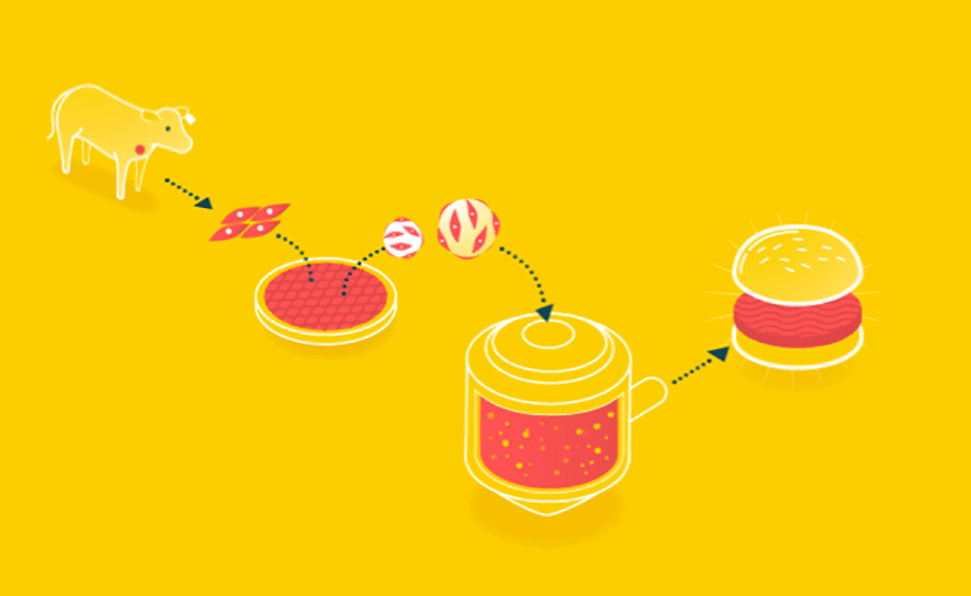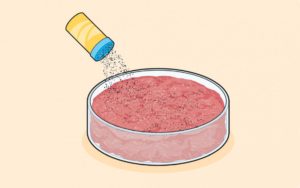
Food is something that has brought together and divided humanity for thousands of years. From obesity crises to conflict driven famines, food has immense economic, political and ecological repercussions. The most pressing of these issues are a booming global population and a planet that is nearing severe biological and environmental damage due to climate change. It is predicted that by 2050, the world population will grow to be around 9 billion. The current methods used to produce food today will not be sustainable for such a population at the expense of over exploitation and consumption of resources. However, with an ongoing technological revolution in agriculture; the way we look and value food will never be the same.
One budding technology to mitigate this growing issue is the use of vertical gardens.  Currently, the vast majority of crops; particularly commodity crops such as soy, corn and wheat are monocropped. This mean that the same genetic strain of crop is consistently planted on the same land without a rotation of crops or a diverse variety of crops. This type of farming is particularly dangerous when coupled with genetic modification because if a particular pest or plant pathogen mutates due to this predictable growing pattern, crops that are heavily relied upon in many industries could be damaged to a point that could leave humanity in hot water. For example if a disease targeted the most common variety of soy, not only could foods that directly rely on those crops disappear but others sectors such as animal agriculture and even industrial manufacturing of plastics. Also, the depletion of soil quality forces farmers to rely heavily on chemical fertilizers and pesticides which could trigger water pollution in addition to accidentally targeting important species such as bees which are critical for pollination of plants. However, vertical gardening will change this vicious cycle in addition to opening new horizons in plant agriculture. Vertical gardening comprises of crops being grown via garden containers, hydroponics, aeroponics and etc. on a roof. The gardens are very beneficial especially in urban settings due to their aesthetic appeal in addition to taking up less space. Not only do these gardens provide cities with food which is important in terms of a global shift from rural to urban communities, but they filter smog, reduce rain run-off and lower energy consumption by reducing heat absorption from the sun. Although vertical gardening has many benefits, the main drawbacks are easing access and maintenance of these gardens in addition to overexposure to sunlight. Also limited space for root development and water drainage for indoor operation could limit what can be planted and slow down the harvesting process.
Currently, the vast majority of crops; particularly commodity crops such as soy, corn and wheat are monocropped. This mean that the same genetic strain of crop is consistently planted on the same land without a rotation of crops or a diverse variety of crops. This type of farming is particularly dangerous when coupled with genetic modification because if a particular pest or plant pathogen mutates due to this predictable growing pattern, crops that are heavily relied upon in many industries could be damaged to a point that could leave humanity in hot water. For example if a disease targeted the most common variety of soy, not only could foods that directly rely on those crops disappear but others sectors such as animal agriculture and even industrial manufacturing of plastics. Also, the depletion of soil quality forces farmers to rely heavily on chemical fertilizers and pesticides which could trigger water pollution in addition to accidentally targeting important species such as bees which are critical for pollination of plants. However, vertical gardening will change this vicious cycle in addition to opening new horizons in plant agriculture. Vertical gardening comprises of crops being grown via garden containers, hydroponics, aeroponics and etc. on a roof. The gardens are very beneficial especially in urban settings due to their aesthetic appeal in addition to taking up less space. Not only do these gardens provide cities with food which is important in terms of a global shift from rural to urban communities, but they filter smog, reduce rain run-off and lower energy consumption by reducing heat absorption from the sun. Although vertical gardening has many benefits, the main drawbacks are easing access and maintenance of these gardens in addition to overexposure to sunlight. Also limited space for root development and water drainage for indoor operation could limit what can be planted and slow down the harvesting process.
Another technology is the introduction of cultured meat or in other words “lab grown meat”.
 As continents such as Africa and Asia grow in population, the global demand for meat and fish in particular will skyrocket. However the current consumption rate of meat and fish has had severe consequences such as deforestation, overfishing, antibiotic resistant bacteria, waste management in addition to high methane and carbon dioxide production which is speeding up the process of climate change. Also, animal agriculture is heavy resource user when it comes to crops, water and arable land. Cultured meat is promising due the fact that it is literally cloned cells from the desired animal being used to synthesize muscles which become a particular type of meat depending on how they are cultivated. Also, cultured meat requires less overhead, space and omits the majority of issues caused by conventional practices. The process begins with starter cells such as embryonic or adult stem cells, myosatellite cells or myoblasts. Stem cells duplicate the faster but they are not dedicated to becoming a specific type of cell which is problematic for splitting them and forcing them to grow a certain way. Developed muscle cells are ideal since they are already in the form of muscle tissue. However, they barely duplicate at all. To address this issue, myoblasts are often used to for their moderate rate of duplication in addition to their ability to differentiate from other cell types. Next, cells are treated with a protein that promotes tissue growth and are placed in a culture medium within a bioreactor which supplies the cells with adequate energy. To protect the meat from yeast and fungus, it is necessary for preservatives such as sodium benzoate to be present.To make the meat three-dimensional, they are grown on a scaffold—specifically an edible one so the meat does not have to be removed. These scaffolds are moved every so often to stretch the developing muscle, simulating the animal body during normal development. Also, 3-D printing technologies such as bioprinters could play an important role. Once this process is initiated, is theoretically possible for meat to be produced infinitely without having to introduce new cells from another animal. Some claim that in an ideal situation, two months of cultured meat can deliver 50,000 tons of meat from ten cells. Some setbacks for cultured meat include scalability, price, ethics and ease of mimicry. As of now, the average price for a pound of cultured meat is around $11.35 which is extraordinarily expensive to its traditional counterparts which on average cost $3.31 per pound. Since cultured meat requires specialized facilities that are sterile and operated with care, the ability to scale such operations will be rather difficult. In order to achieve cultured meat on a commercial scale, there would have to a major evolution in tissue engineering processes. Ethics may become an issue depending on how components such as growth medium and other chemicals are derived, tested and used. Also, the suspicion of genetic modifications and preservation processes being unnatural could make cultured meat more difficult to appeal to the average consumer. Since cultured meat is such a high tech process, communities could struggle be self-sufficient leading to an over dependence on global food corporations. This could add to the dangers of increasing monopolies and an ever so fragile food system.
As continents such as Africa and Asia grow in population, the global demand for meat and fish in particular will skyrocket. However the current consumption rate of meat and fish has had severe consequences such as deforestation, overfishing, antibiotic resistant bacteria, waste management in addition to high methane and carbon dioxide production which is speeding up the process of climate change. Also, animal agriculture is heavy resource user when it comes to crops, water and arable land. Cultured meat is promising due the fact that it is literally cloned cells from the desired animal being used to synthesize muscles which become a particular type of meat depending on how they are cultivated. Also, cultured meat requires less overhead, space and omits the majority of issues caused by conventional practices. The process begins with starter cells such as embryonic or adult stem cells, myosatellite cells or myoblasts. Stem cells duplicate the faster but they are not dedicated to becoming a specific type of cell which is problematic for splitting them and forcing them to grow a certain way. Developed muscle cells are ideal since they are already in the form of muscle tissue. However, they barely duplicate at all. To address this issue, myoblasts are often used to for their moderate rate of duplication in addition to their ability to differentiate from other cell types. Next, cells are treated with a protein that promotes tissue growth and are placed in a culture medium within a bioreactor which supplies the cells with adequate energy. To protect the meat from yeast and fungus, it is necessary for preservatives such as sodium benzoate to be present.To make the meat three-dimensional, they are grown on a scaffold—specifically an edible one so the meat does not have to be removed. These scaffolds are moved every so often to stretch the developing muscle, simulating the animal body during normal development. Also, 3-D printing technologies such as bioprinters could play an important role. Once this process is initiated, is theoretically possible for meat to be produced infinitely without having to introduce new cells from another animal. Some claim that in an ideal situation, two months of cultured meat can deliver 50,000 tons of meat from ten cells. Some setbacks for cultured meat include scalability, price, ethics and ease of mimicry. As of now, the average price for a pound of cultured meat is around $11.35 which is extraordinarily expensive to its traditional counterparts which on average cost $3.31 per pound. Since cultured meat requires specialized facilities that are sterile and operated with care, the ability to scale such operations will be rather difficult. In order to achieve cultured meat on a commercial scale, there would have to a major evolution in tissue engineering processes. Ethics may become an issue depending on how components such as growth medium and other chemicals are derived, tested and used. Also, the suspicion of genetic modifications and preservation processes being unnatural could make cultured meat more difficult to appeal to the average consumer. Since cultured meat is such a high tech process, communities could struggle be self-sufficient leading to an over dependence on global food corporations. This could add to the dangers of increasing monopolies and an ever so fragile food system.
In the end, the future of food is an exciting one filled with opportunities and an overwhelming amount of benefits. With the increasing awareness of how our food affects the world around us, it is critical for these technologies to disrupt the current industries and involve shareholders in these industries to partake in positive change. Also, it up to the public to embrace and even engage in the process. Innovation and invention have always been at the core of human progress and it could change the world if we are willing to encourage one step at a time.
